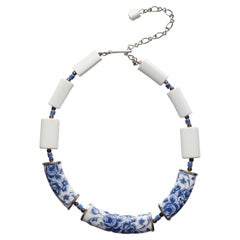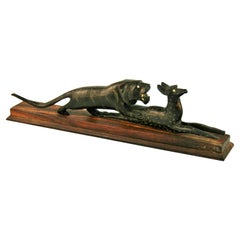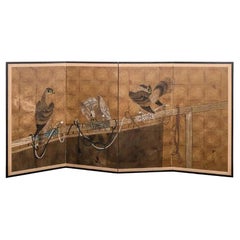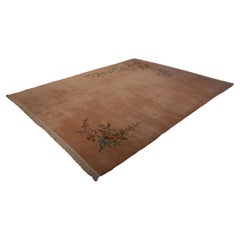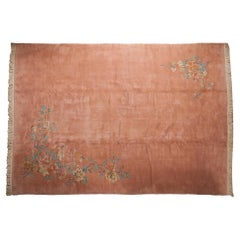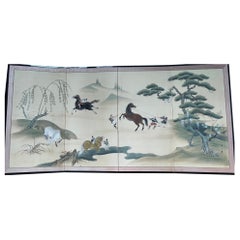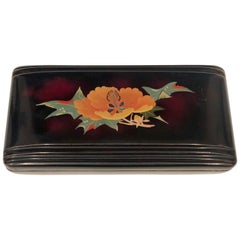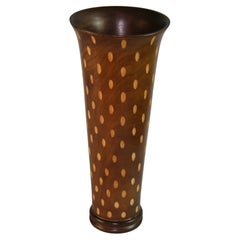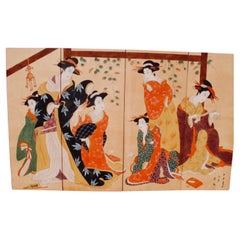Japanese Art Deco
Early 20th Century Asian Art Deco Choker Necklaces
Vintage 1940s Sculptures and Carvings
Ebony
Vintage 1920s Japanese Japonisme Paintings and Screens
Wood
Vintage 1950s Japanese Art Deco Chinese and East Asian Rugs
Wool, Cotton
Vintage 1960s Japanese Art Deco Chinese and East Asian Rugs
Wool, Cotton
Vintage 1920s Japanese Japonisme Paintings and Screens
Wood
20th Century Japanese Chinoiserie Decorative Boxes
Metal, Brass
Vintage 1960s Vases
Hardwood
Vintage 1920s Japanese Japonisme Paintings and Screens
Wood
Early 20th Century Showa Prints
Paper
20th Century Japanese Art Deco Furniture
Wood, Lacquer
Vintage 1920s Japanese Japonisme Toys and Dolls
Ceramic
Early 20th Century Japanese Showa Textiles
Silk
Early 20th Century Japanese Showa Textiles
Silk
Early 20th Century Japanese Showa Textiles
Silk
20th Century Japanese Table Lamps
Metal
Vintage 1930s Japanese Art Deco Tea Sets
Fruitwood
1960s Art Deco Prints and Multiples
Paper
Vintage 1930s Japanese Art Deco Planters, Cachepots and Jardinières
Metal
Early 20th Century Japanese Art Deco Photography
Paper
Vintage 1930s Japanese Art Deco Planters, Cachepots and Jardinières
Bronze
Vintage 1960s Vases
Hardwood
Vintage 1920s Unknown Art Deco Chain Necklaces
Vintage 1930s Japanese Art Deco Decorative Boxes
Lacquer
1920s Art Deco Prints and Multiples
Linen, Paper, Lithograph
2010s Indian Art Deco Indian Rugs
Wool
2010s Indian Art Deco Indian Rugs
Wool
2010s Indian Art Deco Indian Rugs
Wool
2010s Indian Art Deco Indian Rugs
Wool
Vintage 1930s Japanese Art Deco Metalwork
Bronze
Early 20th Century Japanese Art Deco Sculptures and Carvings
Bronze
Mid-20th Century Japanese Art Deco Decorative Art
Glass
Early 20th Century Japanese Art Deco Decorative Art
Silk
Early 20th Century Japanese Art Deco Decorative Art
Silk
2010s American Chinoiserie Pillows and Throws
Linen
Vintage 1920s Japanese Art Deco Ceramics
Ceramic
Mid-20th Century Japanese Decorative Art
Wood
1920s Art Deco Figurative Sculptures
Bronze
Mid-20th Century Japanese Decorative Art
Wood
Early 20th Century Japanese Art Deco Decorative Boxes
Paper
Mid-20th Century French Art Deco More Asian Art, Objects and Furniture
Iron
Vintage 1940s Japanese Art Deco Animal Sculptures
Iron
2010s Art Deco Figurative Drawings and Watercolors
Paper, Charcoal
1930s Prints and Multiples
Linen, Paper, Lithograph
Mid-20th Century Japanese Art Deco Ceramics
Ceramic
Early 20th Century Japanese Metalwork
Bronze
Early 20th Century Japanese Taisho Paintings and Screens
Gold Leaf
Vintage 1940s Japanese Art Deco Animal Sculptures
Ceramic
Early 20th Century Japanese Art Deco Decorative Boxes
Ceramic, Porcelain, Paint
Mid-20th Century Japanese Art Deco Decorative Art
Silk
Mid-20th Century Japanese Art Deco Platters and Serveware
Ceramic
Vintage 1940s Japanese Art Deco Screens and Room Dividers
Mahogany
Mid-20th Century Japanese Art Deco Sculptures and Carvings
Iron
Early 20th Century Japanese Art Deco Jewelry Boxes
Mother-of-Pearl, Wood, Lacquer
Mid-20th Century Japanese Art Deco Vanity Items
20th Century Art Deco Brooches
Diamond, Blue Sapphire, Pink Sapphire, Platinum
Vintage 1930s Japanese Art Deco Vases
Pottery
20th Century Japanese Art Deco Porcelain
Porcelain
Mid-20th Century Japanese Art Deco Decorative Boxes
Lacquer
20th Century French Art Deco Platters and Serveware
Mahogany, Paint, Glass
- 1
- ...
Japanese Art Deco For Sale on 1stDibs
How Much is a Japanese Art Deco?
- 1stDibs ExpertApril 5, 2022There are a variety of different types of Japanese art. One of the oldest and most admired forms of Japanese art is the art of calligraphy, which originated in the sixth or seventh century. Another type of art, ukiyo-e, is the art of the woodblock print, which depicts scenes of female beauties; kabuki actors, sumo wrestlers and more. You’ll find a variety of Japanese artwork from some of the world’s top art dealers on 1stDibs.
- 1stDibs ExpertApril 16, 2024The focus of Japanese art varies. Many traditional Japanese artists sought to capture the beauty of nature in their works. However, other Japanese artists have produced work with Buddhist themes, and contemporary artists working in the country have been inspired by a range of subjects, from socioeconomic and political issues to pop culture. On 1stDibs, explore a large selection of Japanese art.
- 1stDibs ExpertApril 5, 2022The writing on Japanese art is calligraphy art called shodo. It uses Japanese kanji and kana characters. There are a variety of different shodo styles of art, including Kaisho, which is the basic, foundational form of the art. On 1stDibs, find a range of Japanese calligraphy art from top sellers..
- What is the history of Art Deco?1 Answer1stDibs ExpertMarch 25, 2024The history of Art Deco begins in the early 20th century.
Art Deco emerged as a global design style around the start of World War I, during the last years of Art Nouveau's popularity. The style conjures visions of the Roaring Twenties, Machine Age metropolises, vast ocean liners, sleek typography and Prohibition-era hedonism. Its hallmarks include the use of geometric designs influenced by Cubism. Major discoveries of Egyptian tombs during the era also influenced the movement.
The term Art Deco derives from the name of a large decorative arts exhibition, the Exposition Internationale des Arts Décoratifs et Industriels Modernes, held in Paris in 1925. After World War II, tastes shifted toward more functional, less ornate modernism, but today, the Art Deco style is still favored for its luxurious sophistication. On 1stDibs, shop a large selection of vintage Art Deco furniture. - What defines Art Deco?1 Answer1stDibs ExpertApril 5, 2024A few things define Art Deco. Date is one factor, as the style emerged in the 1920s and remained popular during the 1930s. Art Deco design usually includes bold geometric lines and forms or intricate repeating floral motifs. Designers working in this style tended to use expensive materials, such as shagreen or marble, as well as exotic woods like mahogany, ebony and zebra wood. Furniture often featured metal accents, mirrored finishes and embellishments made from exotic animal hides and inlays of mother-of-pearl or ivory. Shop a wide range of Art Deco furniture on 1stDibs.
- What is an Art Deco lamp?1 Answer1stDibs ExpertApril 5, 2022An Art Deco lamp is any lamp that’s made in the styles of the Art Deco movement, which was dominant in the 1920s and 1930s. On 1stDibs, you’ll find a collection of Art Deco lamps from some of the world’s top sellers.
- What is art deco ring?1 Answer1stDibs ExpertAugust 17, 2021Art Deco rings were made during the early 20th century. Named for a design movement that originated at a large decorative arts exhibition held in Paris in 1925, Art Deco rings are generally quite geometric, symmetrical and incorporate a variety of gemstones — especially sapphires and emeralds. Find a wide variety of Art Deco rings for sale on 1stDibs.
- When did Art Deco originate?1 Answer1stDibs ExpertFebruary 1, 2024The Art Deco period originated in France. Its name comes from the title of a large decorative arts exhibition held in Paris in 1925, credited with introducing the style to the world. It was informed by ancient Egypt, Cubism, Futurism, Louis XVI, De Stijl, modernism and the Vienna Secession and went on to influence the Streamline Moderne and mid-century modern movements. Shop a wide range of Art Deco furniture, decorative objects and jewelry on 1stDibs.
- What was Art Deco influenced by?1 Answer1stDibs ExpertMay 3, 2024Art Deco was influenced by a number of things. The discovery of ancient tombs around the turn of the century led to a renewed interest in Egyptian furniture and architecture that inspired Art Deco designers. Art Deco was also informed by Cubism, Futurism, Louis XVI style, De Stijl, modernism and the Vienna Secession. Shop a large collection of Art Deco furniture, decorative objects and jewelry on 1stDibs.
- How do I identify Art Deco?1 Answer1stDibs ExpertApril 5, 2022To identify Art Deco, look for the characteristics of the period. Furniture produced at the time is generally lacquered metal with a mirror-like glossy finish. Wooden items should be an exotic wood. Most items feature symmetrical designs, and geometric forms were popular motifs during the period. In addition, Art Deco often shows the influence of Hellenistic, Egyptian and Asian designs. Shop a variety of Art Deco furniture and decorative objects on 1stDibs.
- What is art deco jewelry?1 Answer1stDibs ExpertFebruary 22, 2021Art Deco jewelry was popular during the design movement of the 1920s and 30s. Art Deco jewelry is typically characterized by geometric patterns and gemstones of contrasting colors.
- What is an art deco watch?1 Answer1stDibs ExpertApril 5, 2022An art deco watch is defined by its geometric case, which is either circular or rectangular. The watch style was highly popular between 1920 and 1950, and is still sought after today. You’ll find a collection of art deco watches from some of the world’s top sellers on 1stDibs
- What was the Art Deco movement?1 Answer1stDibs ExpertMay 30, 2024The Art Deco movement was a decorative style popular during the 1920s and ’30s. Few design styles are as universally recognized and appreciated as Art Deco. The term alone conjures visions of the Roaring Twenties, Machine Age metropolises, vast ocean liners, sleek typography and Prohibition-era hedonism. The iconic movement made an indelible mark on all fields of design, celebrating society's growing industrialization with refined elegance and stunning craftsmanship. Widely known designers associated with the Art Deco style include Émile-Jacques Ruhlmann, Eileen Gray, Maurice Dufrêne, Paul Follot and Jules Leleu. The term Art Deco derives from the name of a large decorative arts exhibition held in Paris in 1925. On 1stDibs, shop a wide range of Art Deco furniture and decorative objects.
- 1stDibs ExpertSeptember 23, 2024What the Japanese sea art is called depends on its type. Many examples of sea art from Japan are called ukiyo-e. This term refers to woodblock prints made during the 17th, 18th and 19th centuries. The Great Wave off Kanagawa by Katsushika Hokusai is arguably the most famous ukiyo-e print depicting the sea. On 1stDibs, find a wide variety of Japanese woodblock prints.
- 1stDibs ExpertOctober 15, 2024To tell if art is Japanese or Chinese, study the piece's characteristics. With paintings, Chinese artists often use more color and tend to fill their entire canvases, while Japanese artists often include more negative space and choose subtler colors. There are also differences between the brushstrokes typical of traditional Chinese and Japanese art. In Japanese paintings, brushstrokes are often short and sharp. On the other hand, Chinese paintings often display longer, more fluid brushstrokes. Learning about the defining features of various art forms and periods and looking at examples of pieces made by Japanese and Chinese artists can help you learn to spot subtle differences. Explore a diverse assortment of Japanese and Chinese art on 1stDibs.
- 1stDibs ExpertApril 5, 2022Many art styles originated in Japan and grew in popularity over the years. Some of the most popular styles include shodo (calligraphy), ikebana, kanou and yamato-e. You’ll find a wide variety of authentic Japanese art from some of the world’s top dealers on 1stDibs.
- 1stDibs ExpertApril 5, 2022What Japanese wall art is called depends on its type. There are numerous kinds of Japanese paintings and prints, including nihonga and ukiyo-e. A Japanese wall scroll is known as a kakejiku or kakemono. On 1stDibs, find a variety of Japanese wall art.
- 1stDibs ExpertAugust 15, 2019
The main difference between Art Nouveau and Art Deco is that the former is detailed and ornate, and the latter is sharp and geometrical. When the movement started at the end of the 19th century, Art Nouveau was heavily influenced by nature and the curved lines of flowers. Art Deco, which became popular in the beginning of the 20th century, was inspired by the geometric abstraction of cubism.
- 1stDibs ExpertAugust 26, 2024The difference between Art Deco and mid-century modern (MCM) is that the terms describe two distinct design styles. Art Deco typically refers to pieces produced between the 1920s and 1930s. Furniture produced in this style tends to display bold geometric lines and forms, floral motifs, metal accents, shimmering mirrored finishes and embellishments made from exotic animal hides, inlays of mother-of-pearl or ivory. MCM, or mid-century modern, emerged after World War II. Organically shaped, clean-lined and elegantly simple are three terms that well describe vintage mid-century modern furniture. Designers working in this style frequently used industrial materials, including steel, fiberglass, molded plywood, and alluring woods such as teak, rosewood and oak. Explore a wide variety of Art Deco and mid-century modern furniture on 1stDibs.
- Was Eileen Gray Art Deco?1 Answer1stDibs ExpertFebruary 21, 2024The answer to whether Eileen Gray's designs were Art Deco depends on which piece you're considering. Gray was ever-evolving as a designer. By the early 1920s, she was creating geometric works that embodied the essence of Art Deco and the nascent modernist design movement. Some pieces, like her Bricks screen, employ the planar forms favored by Gerrit Rietveld and other De Stijl architects of the Netherlands. Others feature the tubular chrome framing used by Marcel Breuer and Ludwig Mies van der Rohe, who are associated with the mid-century modern design style. On 1stDibs, shop a variety of Eileen Gray furniture.
